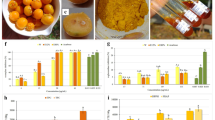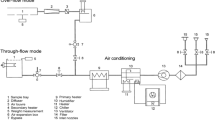Abstract
Purpose
To investigate the biological activities and physicochemical properties of Lactococcus lactis-fermented guava (Psidium guajava, Punjab pink var) pulp powders prepared using freeze drying (FD).
Method
Proximate composition of these powders was determined using standard protocols by the DPPH radical scavenging assay. The powder samples were examined for biological activities—alpha glucosidase and angiotensin inhibition. SEM was used to determine morphology of FD powders; textural analysis was carried out instrumentally and sensory evaluation using 9-point hedonic scale. Microbiological analysis and shelf life (3 months) properties of powder samples were done as per recommended guidelines.
Result
The FD-stabilized fermented guava powders consisted of protein (5.8 ± 0.01 mg/100 g), fat (3.9 ± 0.04 mg/100 g), moisture (4.82 ± 0.003 g water/g d.b), and carbohydrates (30.8 ± 0.92 mg/100 g). Vitamin C (119.2 ± 8.78 mg/100 g), lycopene (703 ± 6.77 mg/GAE/g), and antioxidant activity (81.2% ± 3.30). Alpha glucosidase activity and angiotensin inhibitory activities were (IC50) 3.40 ± 0.08 and 2.52 ± 0.31 µg/mL, respectively, did not differ significantly (p > 0.05) than those observed in fermented pulp. Significant (p < 0.05) reduction of these values occurred in hot air-dried (HD) powders. SEM indicated uniformly distributed pores in FD-stabilized powders. Textural analysis of powders revealed these to be free flowing with low cohesive index (CI: 4.33) and caking tendency (mean caking strength: 177.37). FD guava powders that received high sensory scores were shelf stable at 28 °C for up to 3 months with insignificant (p > 0.05) changes in biological activities. The APC < 1 CFU and absence of molds and yeasts, coliforms, and Staphylococcus aureus in guava powders indicated microbiological safety.
Conclusion
The physicochemical properties and biological activities of L. lactis-fermented guava pulps can be effectively stabilized as a valuable food ingredient using FD for developing a functional food ingredient and a safe, healthy choice of nutrition.


Similar content being viewed by others
Data availability
Data of this study can be made available through a modest request to the corresponding author.
References
Negi S, Neeraj A. Post-harvest losses and wastage in Indian fresh agro supply chain industry: a challenge. IUP J Suppl Chain Manag. 2018;14(2):7–23. https://www.proquest.com/docview/1916950498. Accessed 19 Dec 2023.
Garcia EF, Luciano WA, Xavier DE, da Costa WCA, de Sousa OK, Franco OL, de Morais Jr MA, Lucena BTL, et al. Identification of lactic acid bacteria in fruit pulp processing by products and potential probiotic properties of selected Lactobacillus Strains. Front Microbiol. 2016;7:1371. https://doi.org/10.3389/fmicb.2016.01371.
Palachum W, Choorit S, Manurakchinakorn S, Chisti Y. Guava pulp fermentation and processing to a vitamin B12-enriched product. J Food Process Preserv. 2020;44(8):36–41. https://doi.org/10.1111/jfpp.14566.
Ghosh M, Kaur H. (2023). Antidiabetic and nutritional properties of guava (Psidium guavaja L.) pulp (fermented with Lactococcus lactis), The Functional Foods: Nutrient and Health Benefits, Ed. Megh R Goyal, Apple Academic press, USA.
Jiang H, Zhang M, Adhikari B. (2013). Fruit and vegetable powders. Handbook Of Food Powders. Woodhead Publishing Series in Food Science, Technology and Nutrition, Woodhead Publishers, UK.532–552
Kaur H, Ghosh M. Probiotic fermentation enhances bio accessibility of lycopene, polyphenols, and antioxidant capacity of guava fruit (Psidium guajava L). Intl J Agric Food Res. 2023;14:100704. https://doi.org/10.1016/j.jafr.2023.100704.
Hur SJ, Lee SY, Kim YC, Choi I, Kim GB. Effect of fermentation on the antioxidant activity in plant-based foods. Food Chem. 2014;160:346–56. https://doi.org/10.1016/j.foodchem.2014.03.112.
Qureshi MN, Stecher G, Bonn GK. Determination of total polyphenolic compounds and flavonoids in Juglans regia leaves. Pak J Pharm Sci. 2014;27(4):865–9.
AOAC. Association of official analytical chemists. (2000). Official methods of analysis, 17th edition, Washington, DC. USA.16th ed. Gaithersburg, USA: AOAC International.
Shabbir H, Kausar T, Noreen S, Rehman HU, Hussain A, Huang Q, Gani A, Su S, Nawaz A. In vivo screening and antidiabetic potential of polyphenol extracts from guava pulp seeds and leaves. Animals. 2020;10(9):1714. https://doi.org/10.3390/ani10091714.
Chawla C, Kaur D, Oberoi DPS, Sogi DS. Drying characteristics, sorption isotherms, and lycopene retention of tomato pulp. Drying Technol. 2008;26(10):1257–64. https://doi.org/10.1080/07373930802307225.
Cushman DW, Cheung HS. Spectrophotometric assay and properties of angiotensin converting enzyme from rabbit lungs. Biochem Pharmacol. 1971;20(7):1637–48.
Downes FP, Ito K. Compendium of methods for the microbiological examination of foods. 4th ed. Washington: American Public Health Association; 2001.
Chinnasamy G, Dekeba K, Prabhu V. Physicochemical properties of tef starch: morphological, thermal, thermogravimetric, and pasting properties. Int J Food Prop. 2022;25(1):1668–82. https://doi.org/10.1080/10942912.2022.2098973.
Marques LG, Ferreira MC, Freire JT. Freeze-drying of acerola (Malpighia glabra L.). Chem Eng Process. 2007;46:451–7. https://doi.org/10.1016/j.cep.2006.04.011.
Bhatta S, Stevanovic Janezic T, Ratti C. (2020). Freeze-drying of plant-based foods. Foods 13:9(1),87. https://doi.org/10.3390/foods9010087.
Patil V, Chauhan AK, Singh SP. (2014). Influence of spray drying technology on the physical and nutritional properties of guava powder International Journal of Current Microbiology and Applied Sciences 3 (9) :1224–1237.ISSN: 2319–7706.
Tan S, Lan X, Chen S, Zhong X, Wenfeng L. (2023). Physical character, total polyphenols, anthocyanin profile and antioxidant activity of red cabbage as affected by five processing methods Food Research International 169, 112929 https://doi.org/10.1016/j.foodres.2023.112929
Rodrìguez H, Curiel JA, Landete JM, Las Rivas B, de Felipe FL, Gòmez-Cordovés CG. Food phenolics and lactic acid bacteria. Int J Food Microbiol. 2009;132(2–3):79–90. https://doi.org/10.1016/j.ijfoodmicro.2009.03.025.
Kasunmala IGG, Navarathne SB, Wickramasinghe I. (2021). Effect of drying methods on antioxidant activity of Syzygium Caryophyllatum (L.) Fruit Pulp, Intl J Fruit Sci 21(1): 634–644, DOI: https://doi.org/10.1080/15538362.2021.1911744
LeBlanc JG, Laiño JE, del Valle, MJ,Vannini, VD,van Sinderen,MP, de Valdez, GF,de Giori GS, Sesma F.(2011).B-group vitamin production by lactic acid bacteria--current knowledge and potential applications, J Appl Microbiol 111(6): 297–309, DOI: https://doi.org/10.1111/j.1365-2672.2011.05157.x.
Manna K, Mishra S, Saha M, Mahapatra S, Saha C, Yenge G, Gaikwad N, Pal R, Oulkar D, Banerjee K, Das Saha K. (2019). Amelioration of diabetic nephropathy using pomegranate peel extract-stabilized gold nanoparticles: assessment of NF-κB and Nrf2 signalling system. International Journal of Nanomedicine 7(14):1753–1777. doi: https://doi.org/10.2147/IJN.S176013.
Kusumawati GAW, Adhi Putra MW, Yogeswara IBA. In vitro ACE inhibitory activity and bioactive compounds of aqueous extract of Citrus amblycarpa. Tradition Med J. 2021;26(2):118–212.
Abd Ghani A, Abd Rashid N, Abd Razak DL, Jamaluddin A, Abdul Manan M, Mansor A. The effects of heat treatments on the bioactive compounds, antioxidant activity, and cosmeceutical properties (anti-pigmentation and anti-ageing) of fermented broken rice. Food Res. 2023;6(Suppl. 2):155–62.
Shishir MRI, Taip FS, Aziz NA, Talib RA. Physical properties of spray-dried pink guava (Psidium guajava) powder. Agric Agric Sci Procedia. 2014;2:74–81. https://doi.org/10.1016/j.aaspro.2014.11.011.
FSSAI. Food Safety and Standards Authority of India. (2011). Food Safety and Standards (Food Product Standards and Food Additives) regulation (Part II), pp.496–503, 2011.
García-Martínez E, Camacho MDM, Martínez-Navarrete N. (2023). In vitro bio accessibility of bioactive compounds of freeze-dried orange juice co-product formulated with gum Arabic and modified starch. Molecules 13,28(2):810. doi: https://doi.org/10.3390/molecules28020810.
Leiton-Ramírez, YM, Ayala-Aponte A, Ochoa-Martínez CI. Physicochemical properties of guava snacks as affected by drying technology. (2020). Processes 8(106): 2–12.
Funding
Funding was made available from TIET-TAU Food Security Centre of Excellence (T2CEFS; grant code: T2CEFS/MG).
Author information
Authors and Affiliations
Contributions
MG (Moushumi Ghosh) acquired funding, designed the study, and wrote the manuscript. HK (Harshpinder Kaur) performed the experiments. Both authors have consent to the final submitted manuscript draft.
Corresponding author
Ethics declarations
Ethics approval and consent to participate
Ethical approvals are not applicable. The author and co-author have complete consent for participation in the study and publication.
Consent for publication
The corresponding author and co-author have complete consent for publication.
Competing interests
The authors declare no competing interests.
Supplementary Information
Below is the link to the electronic supplementary material.
Rights and permissions
Springer Nature or its licensor (e.g. a society or other partner) holds exclusive rights to this article under a publishing agreement with the author(s) or other rightsholder(s); author self-archiving of the accepted manuscript version of this article is solely governed by the terms of such publishing agreement and applicable law.
About this article
Cite this article
Kaur, H., Ghosh, M. Effect of freeze drying on alpha glucosidase, angiotensin (ACE) inhibition, and nutritional properties of Lactococcus lactis-fermented guava fruit powder. Nutrire 49, 21 (2024). https://doi.org/10.1186/s41110-024-00263-w
Received:
Accepted:
Published:
DOI: https://doi.org/10.1186/s41110-024-00263-w




